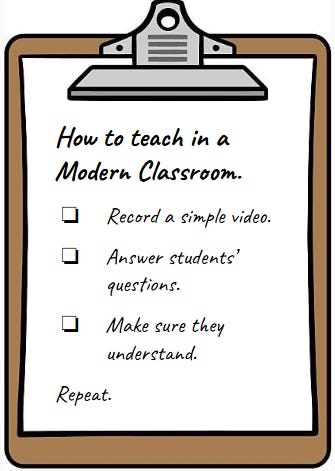First of all, I want to welcome all of you who joined me for my webinar on “3 Simple Strategies” earlier this week. It was a great conversation and I hope you’ll join another upcoming discussion, too!
Anyways - my book came out this week. Maybe people will read it; maybe they won’t. I hope they will, but who knows? At this point, it’s out of my hands.
One thing I’ve been thinking about, therefore, is what if anything I learned from writing Meet Every Learner’s Needs. Whether people read the book or not, I want to understand if - or perhaps to convince myself that - the very act of writing the book had value.
Fortunately, I think it did. Because I think it taught me this:
Big change starts small.
And I hope that, whether you read the book or not, it’s something you’ll take away from my and MCP’s story.
I think the reason I needed to learn that - or, perhaps, remember it - is because, for the past seven or so years, I’ve presented the Modern Classroom model as a comprehensive approach to redesigning instruction.
And it is! Our model is an evidence-based pedagogy that revolutionizes teaching and learning at scale. As I’ve said many times, this approach transformed my classroom and saved my career.
But I realized while writing the book that, while pitches like the one above have helped MCP attract funding and partnerships, they don’t actually reflect how the Modern Classroom model was born, or what (at least to me) it really is.
The Modern Classroom model is a series of small steps.
When I was a struggling teacher at Eastern Senior High School, I wasn’t looking for comprehensive instructional models! I was looking for things I could do each day to make that day a little better than the last, so I wouldn’t go home every night feeling like I had failed.
That’s why I recorded my first videos! Delivering direct instruction live from my whiteboard was exhausting, so I tried videos instead. Once I had videos, I enjoyed class more, and got home each evening feeling a little bit better. No grand vision for “blended instruction there” - just a technique that worked.
That’s also why I allowed self-pacing! It was stressful when some students finished my videos lessons fast, and others needed more time. But if I let the fast-moving students keep moving, and took the pressure off the slower-moving ones, it was calmer. I only built “self-paced structures” because they were what I felt my students and I needed.
Finally, that’s why I instituted Mastery Checks! In a self-paced class it was difficult to know when students should move from one lesson to the next, so I developed Mastery Checks as a way to regulate their progress. “Mastery-based learning” was a natural result of the steps I’d already taken.
And one day, after months of incremental improvements, I looked up and my class had been transformed.
The grand vision inspires change, but the small steps make it happen.
When I started writing my book, I spent weeks debating how to order the chapters. Should I start with “blended instruction,” “self-paced structures,” or mastery-based learning?” I couldn’t decide. These abstract concepts were all so intertwined.
And then I decided: just write down what I did, step by simple step. Focus on the actions that built the model, not the finished product. So that’s what I did.
The book describes big change, but in a series of small steps.
And one small step for a teacher can be a giant leap for teaching. 🚀
Two steps to take now
It’s easy to talk about taking small steps, and perhaps harder to know where to start. So here are two things I recommend you do.
Draft your own Modern Classroom lesson. I keep mentioning Insta~Lesson here, but only because I think it’s the easiest possible way to build a lesson that can meet every learner’s needs. In fact, writing the book is what inspired me to create it! Take two minutes (literally) and draft a blended, self-paced, mastery-based lesson that you can print and give to your students the next time you see them.
Record your own video. The first step for me - and the first step in the book - is to digitize direct instruction with a concise instructional video. It might sound hard, but with the right guidance it can be quite easy. Here’s that guidance.
I’m willing to bet that, if you show up to class on Monday with a refined Insta~Lesson and/or your own instructional video, both you and your students will benefit.
Three ways to use Meet Every Learner’s Needs
Now that the book is out at last, I want to share three ways in which I hope it can help you succeed. You’ll be the judge of that, of course, but I hope you’ll consider:
Organizing a book study. Use the book to spark discussion and build community. I’d be happy to join a session virtually, too.
Following the implementation guide. Teaching in a Modern Classroom isn’t quite so simple as the checklist I showed above, but it’s really not all that much harder. This checklist, which accompanies the book, shows all the steps you need.
Sharing with your administrators. If you’d like to connect me directly with your admin, just let me know. I’ve got extra copies of the book I can share.
It was nice to write a book that helped me reflect, but it will be much nicer if this book helps you, your students, and even your colleagues succeed.





